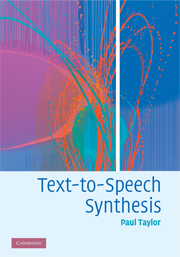Book contents
- Frontmatter
- Contents
- Foreword
- Preface
- 1 Introduction
- 2 Communication and language
- 3 The text-to-speech problem
- 4 Text segmentation and organisation
- 5 Text decoding: finding the words from the text
- 6 Prosody prediction from text
- 7 Phonetics and phonology
- 8 Pronunciation
- 9 Synthesis of prosody
- 10 Signals and filters
- 11 Acoustic models of speech production
- 12 Analysis of speech signals
- 13 Synthesis techniques based on vocal-tract models
- 14 Synthesis by concatenation and signal-processing modification
- 15 Hidden-Markov-model synthesis
- 16 Unit-selection synthesis
- 17 Further issues
- 18 Conclusion
- Appendix A Probability
- Appendix B Phone definitions
- References
- Index
12 - Analysis of speech signals
Published online by Cambridge University Press: 25 January 2011
- Frontmatter
- Contents
- Foreword
- Preface
- 1 Introduction
- 2 Communication and language
- 3 The text-to-speech problem
- 4 Text segmentation and organisation
- 5 Text decoding: finding the words from the text
- 6 Prosody prediction from text
- 7 Phonetics and phonology
- 8 Pronunciation
- 9 Synthesis of prosody
- 10 Signals and filters
- 11 Acoustic models of speech production
- 12 Analysis of speech signals
- 13 Synthesis techniques based on vocal-tract models
- 14 Synthesis by concatenation and signal-processing modification
- 15 Hidden-Markov-model synthesis
- 16 Unit-selection synthesis
- 17 Further issues
- 18 Conclusion
- Appendix A Probability
- Appendix B Phone definitions
- References
- Index
Summary
In this chapter we turn to the topic of speech analysis, which tackles the problem of deriving representations from recordings of real speech signals. This book is of course concerned with speech synthesis – and at first sight it may seem that the techniques for generating speech “bottom-up” as described in Chapters 10 and 11 may be sufficient for our purpose. As we shall see, however, many techniques in speech synthesis actually rely on an analysis phase, which captures key properties of real speech and then uses these to generate new speech signals. In addition, the various techniques here enable useful characterisation of real speech phenomena for purposes of visualisation or statistical analysis. Speech analysis then is the process of converting a speech signal into an alternative representation that in some way better represents the information which we are interested in. We need to perform analysis because waveforms do not usually directly give us the type of information we are interested in.
Nearly all speech analysis is concerned with three key problems. First, we wish to remove the influence of phase; second, we wish to perform source/filter separation, so that we can study the spectral envelope of sounds independently of the source that they are spoken with. Finally, we often wish to transform these spectral envelopes and source signals into other representations that are coded more efficiently, have certain robustness properties, or more clearly show the linguistic information we require.
- Type
- Chapter
- Information
- Text-to-Speech Synthesis , pp. 341 - 386Publisher: Cambridge University PressPrint publication year: 2009



